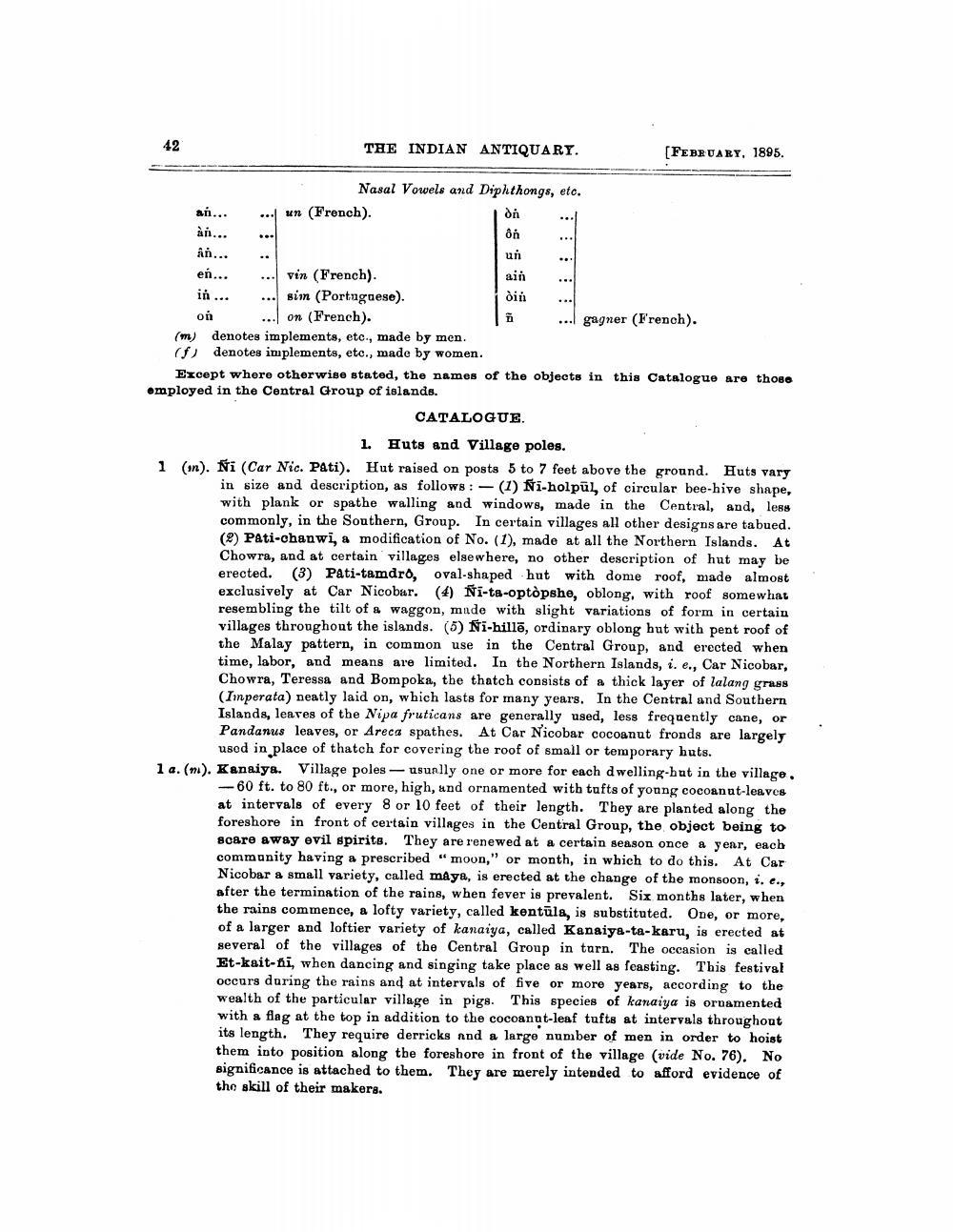________________
12
THE INDIAN ANTIQUARY.
[FEBRUARY, 1895.
Nasal Vowels and Diphthongs, etc. ...un (French).
:
... vin (French).
sim (Portugaese). on (French).
... gagner (French). (m) denotes implements, etc., made by men. (fdenotes implements, etc., made by women.
Except where otherwise stated, the names of the objects in this Catalogue are those omployed in the Central Group of islands.
CATALOGUE
1. Huts and Village poles. 1 (on). Ni (Car Nic. Pati). Hut raised on posts 5 to 7 feet above the ground. Huts vary
in size and description, as follows:-(1) Ni-holpul, of circular bee-hive shape, with plank or spathe walling and windows, made in the Central, and, less commonly, in the Southern, Group. In certain villages all other designs are tabued. (9) PAti-chanwi, a modification of No. (1), made at all the Northern Islands. At Chowra, and at certain villages elsewhere, no other description of hut may be erected. (3) Pati-tamdro, oval-shaped hut with dome roof, made almost exclusively at Car Nicobar. (4) Ni-ta-optòpshe, oblong, with roof somewhat resembling the tilt of waggon, made with slight variations of form in certain villages throughout the islands. (5) Ni-hillē, ordinary oblong hut with pent roof of the Malay pattern, in common use in the Central Group, and erected when time, labor, and means are limited. In the Northern Islands, i. e., Car Nicobar, Chowra, Teressa and Bompoka, the thatch consists of a thick layer of lalang grass (Inperata) neatly laid on, which lasts for many years. In the Central and Southern Islands, leaves of the Nipa fruticans are generally used, less frequently cane, or Pandanus leaves, or Areca spathes. At Car Nicobar cocoanut fronds are largely
used in place of thatch for covering the roof of small or temporary huts. 1 a. (mn). Kanaiya. Village poles - usunlly one or more for each dwelling-but in the village.
- 60 ft. to 80 ft., or more, high, and ornamented with tafts of young cocoanat-leaves at intervals of every 8 or 10 feet of their length. They are planted along the foreshore in front of certain villages in the Central Group, the object being to scare away evil spirits. They are renewed at a certain season once a year, each community having a prescribed "moon," or month, in which to do this. At Car Nicobar a small variety, called maya, is erected at the change of the monsoon, i. e., after the termination of the rains, when fever is prevalent. Six months later, when the rains commence, a lofty variety, called kentūla, is substituted. One, or more, of a larger and loftier variety of kanaiya, called Kanaiya-ta-karu, is erected at several of the villages of the Central Group in turn. The occasion is called Et-kait-fi, when dancing and singing take place as well as feasting. This festival occurs during the rains and at intervals of five or more years, according to the wealth of the particular village in pigs. This species of kanaiya is ornamented with a flag at the top in addition to the cocoanat-leaf tufts at intervals throughout its length. They require derricks and a large number of men in order to hoist them into position along the foreshore in front of the village (vide No. 76). No significance is attached to them. They are merely intended to afford evidence of the skill of their makers.




